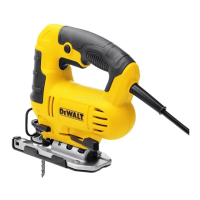7
ENGLISH
Switching On and Off (Fig.A)
• To switch the tool on, squeeze the trigger switch
1
.
Proper Hand Position (Fig.D)
WARNING: To reduce the risk of serious personal injury,
ALWAYS use proper hand position asshown.
WARNING: To reduce the risk of serious personal
injury, ALWAYS hold securely in anticipation of a
suddenreaction.
Proper hand position requires one hand on the front handle
12
,
with the other hand on the main handle
13
.
WARNING:
• Make sure your workpiece is well secured. Remove
nails, screws and other fasteners that may damage
theblade.
• Check that there is sufficient space for the blade
underneath the workpiece.
• Do not cut materials that exceed the maximum
cutting depth of theblade.
• Use sharp saw blades only. Damaged or bent saw
blades must be removedimmediately.
• Do not use the tool for sawing pipes ortubes.
• Never run your tool without a sawblade.
• For optimal results, move the tool smoothly and
constantly over the workpiece. Do not exert lateral
pressure on the saw blade. Keep the shoe flat on the
workpiece and lead the cord away in line with the tool.
When sawing curves, circles or other round shapes,
push the tool gentlyforward.
• Wait until the tool has come to a standstill before
removing the saw blade from the workpiece. After
sawing the blade may be very hot. Do nottouch.
OPERATION
Instructions for Use
WARNING: Always observe the safety instructions and
applicableregulations.
WARNING: To reduce the risk of serious personal
injury, turn tool off and disconnect tool from power
source before making any adjustments or removing/
installing attachments or accessories. An accidental
start‑up can causeinjury.
5. Push the shoe beveling lever back towards the saw to lock
theshoe.
To Reset the Shoe for Straight Cuts
1. Pull the shoe beveling lever
7
out and away from the saw
to unlock the shoe
6
as shown in FigureC.
2. Rotate shoe to an angle of approximately 0° and then pull
shoe backwards to engage the 0° positivestop.
3. Push the shoe beveling lever back towards the saw to lock
theshoe.
Adjusting the Shoe for Bevel Cuts (Fig.C)
WARNING: Never use the tool when the shoe is loose or
removed. The shoe plate can be set to a left or right bevel
angle of up to 45°.
To Set the Bevel Angle
1. Pull the shoe beveling lever
7
out and away from the saw
to unlock the shoe
6
as shown in FigureC.
2. Slide the shoe forward to release it from the 0° positive
stopposition.
3. The shoe can be beveled to the left or to the right and has
detents at 15°, 30° and 45°.
4. Set the shoe to the desired bevel angle. Use a protractor to
verify angleaccuracy.
Blade Installation (Fig.B)
WARNING: When mounting the saw blade wear
protective gloves. danger of injury when touching the
sawblade.
WARNING: Use only T type blades. Using blades other
than T type blades cause insufficient tightening of the
blade, resulting in a serious personalinjury.
1. Push the saw blade locking lever
3
upward.
2. With teeth facing forward, insert the shank of the saw blade
into the blade holder as far as it willgo.
3. Release thelever.
4. Check to ensure blade is secure before cutting. A loose saw
blade can fall out an lead toinjury.
ASSEMBLY AND ADJUSTMENTS
WARNING: To reduce the risk of serious personal
injury, turn tool off and disconnect tool from power
source before making any adjustments or removing/
installing attachments or accessories. An accidental
start‑up can causeinjury.
Intended Use
Your jig saw has been designed for professional
sawingapplications.Your DeWALT jig saw, DWE349 or , has
been designed for sawing wood,plastics, metal, rubber and
ceramicplates
DO NOT use under wet conditions or in the presence of
flammable liquids orgases.
These jigsaws are professional powertools.
DO NOT let children come into contact with the tool.
Supervision is required when inexperienced operators use
thistool.
• Young children and the infirm. This appliance is not
intended for use by young children or infirm persons
without supervision.
• This product is not intended for use by persons (including
children) suffering from diminished physical, sensory or
mental abilities; lack of experience, knowledge or skills
unless they are supervised by a person responsible for their
safety. Children should never be left alone with thisproduct.

